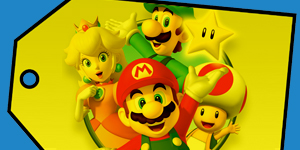Extra: Invasion of the Crossovers
Mario and… Sonic? Street Fighter and… Tekken? Final Fantasy and… Disney? These are the types of video game mash-ups that playground dreams were made of. These dreams have not only become a reality in recent years, but are quickly becoming a new norm. In an age where game development costs are rapidly rising and publishers are looking for extra ways to save money, video game crossovers – collaborations between multiple companies that bring together their popular franchises – certainly make sense. They’re more cost effective and instantly more marketable by appealing to multiple fan bases at once. Yet even with this sudden upswing in releases, such crossovers are nothing new. Dating back to 1993’s Battletoads and Double Dragon: The Ultimate Team for the NES, crossovers have had their place in the gaming space. A place that is now expanding into new genres with characters you may never expect.
Traditionally, the easiest way to bring together the diverse universes of different game franchises was to just throw them in the blender of the fighting genre. It’s the core concept of Nintendo’s own Super Smash Bros. franchise and the driving force behind an assortment of Capcom crossover classics such as the Marvel vs. Capcom series, the SNK vs. Street Fighter series, and the Wii’s anime-infused Tatsunoko vs. Capcom: Ultimate All-Stars. Here, it doesn’t matter why Captain America is fighting Mega Man, or why Fatal Fury’s Terry has it out for Street Fighter’s Chun-Li. All that matters is that players get to see exactly which of their favorites reign supreme, all while generating easy money for the companies involved.

Naturally, as time went on, crossovers began to creep into other genres. One of the first notable games that went in a new direction was SNK vs. Capcom: Card Fighters Clash for the ill-fated Neo Geo Pocket Color. Released in 1999 (with an eventual DS sequel in 2007), this card-dueling title took the concept of the fighting crossover and slowed it down with turn-based battles and a story. In other words, it turned the fast-paced fighting crossover into an RPG and showed that yes, you can actually give some depth to these crazy video game mishmashes. Such an idea was later proved to be extremely successful with the 2002 release of Kingdom Hearts for PlayStation 2. Combining the worlds of Square Enix RPGs with the magic kingdom of Disney, the series has not just been a huge cash cow, but has also further expanded the idea of what a crossover game can be. Instead of simply pitting Disney against Final Fantasy, the developers created new characters and an entirely original story that weaves through the worlds of Disney and Square Enix.
One could argue that Kingdom Hearts was the turning point for crossover games. It was the moment where crossovers simply didn’t throw franchises at each other, but allowed for them to dive into and build upon existing canon. Sure, we still have plenty of head-to-head crossover games: for every Kingdom Hearts, there’s a Street Fighter x Tekken or Mortal Kombat vs. DC Universe. However, there are also games that provide much more depth for the crossovers, such as last year’s Pokemon Conquest, a DS title that blended the turn-based strategy of Tecmo Koei’s popular Nobunaga’s Ambition franchise (only released in Japan) with the pocket monsters we all know and love.

On the horizon is an impressive trio of crossover games that follow this newer trend of fleshed out stories and concepts. A localized version of Project X Zone has been confirmed, bringing a three-way Capcom, Sega, and Namco Bandai crossover to North America later this year. Capcom and Namco previously dabbled in the realm of crossover RPGs with 2005’s Namco x Capcom for PlayStation 2. This 3DS game, however, ups the ante with the addition of Sega and tons of inside jokes and references than fans will surely appreciate. The story provides a rather standard take on the “universes colliding” idea with a plot that literally revolves around a mysterious force smashing the characters’ worlds together, but it goes deeper as the developers at Monolith Soft devised logical connections between the various characters using each franchise’s own back story. A plotless fighting game mash-up, this is not.
Similarly impressive to Project X Zone’s commitment to back story is Professor Layton vs. Ace Attorney. Released for 3DS in Japan last year, this title literally brings together the core storylines and gameplay of the top hat-wearing Professor Layton (with his assistant Luke) and court room mainstay Phoenix Wright (with his assistant Maya Fey). The story follows Layton and Phoenix as they are independently transported to a medieval town, and the gameplay plays out like both of the franchises it draws upon. Players are required to explore the environment and solve brain teasers à la Professor Layton, as well partake in court trials as in Ace Attorney. Unfortunately, Level-5 and Capcom have not yet announced a North American release date for this ambitious crossover.

An equally noteworthy crossover with an equally non-existent release date is the recently announced Shin Megami Tensei x Fire Emblem for Wii U. Details are slim thus far, but we do know it’s an RPG that is primarily being handled by Shin Megami Tensei publisher Atlus with input from both Nintendo and Fire Emblem developer Intelligent Systems. We also know that it is the start of a new trend for Nintendo’s own game development process and a great example of why crossovers are becoming more and more common in the industry. When unveiling the game in a recent Nintendo Direct, Nintendo global president Satoru Iwata emphasized that with rising development costs and the increased workload required by today’s development process, partnerships with outside developers and crossovers such as this one are key. “We are working with many more partners on additional collaborations,” Iwata teased. “Please looked forward to hearing about them.”
So what will those future collaborations entail? Will we see more deep crossover titles along the lines of Kingdom Hearts and Professor Layton vs. Ace Attorney? Or perhaps entirely new takes on the concept, similar to how Mario and Sonic at the Olympic Games brought the mascot rivalry into the sports world or how Tetris DS combined the classic puzzler with Nintendo’s own big names? Only time will tell, but one thing is certain: crossover games are here to stay.




Interesting read Jason!
Thanks, glad you enjoyed it!